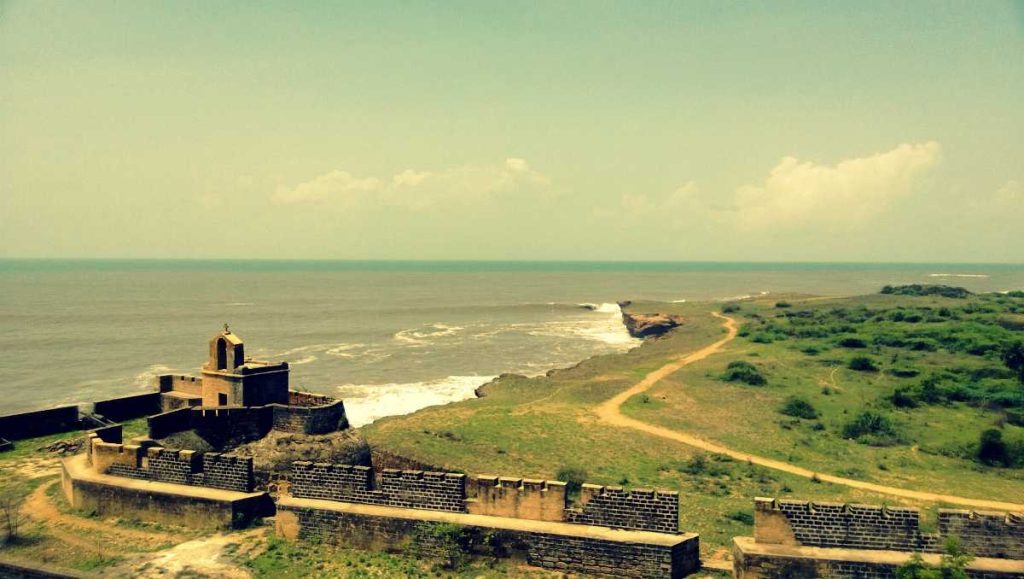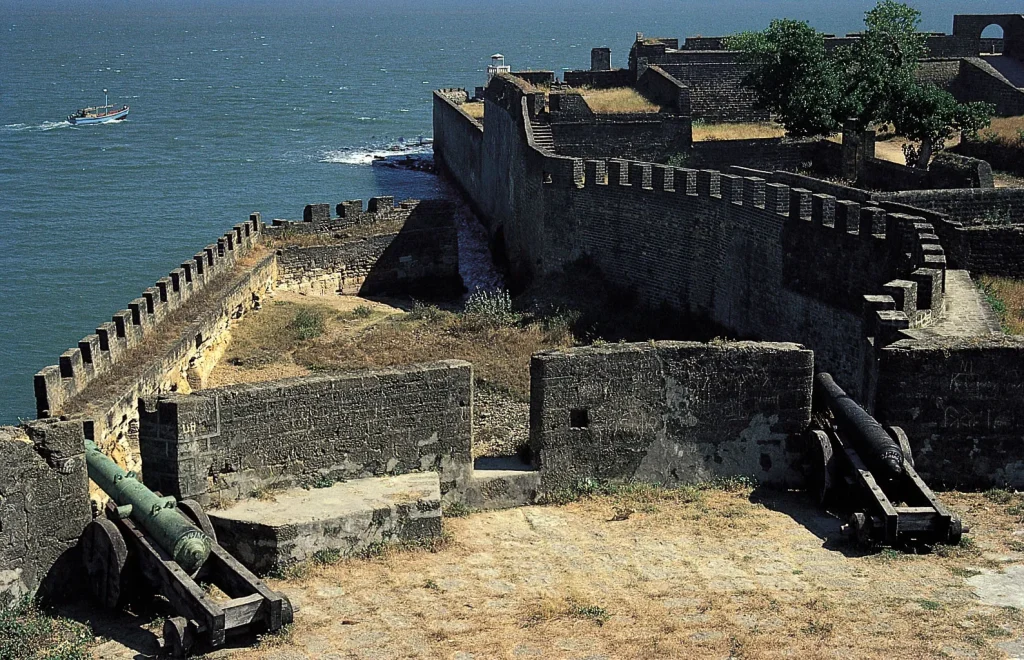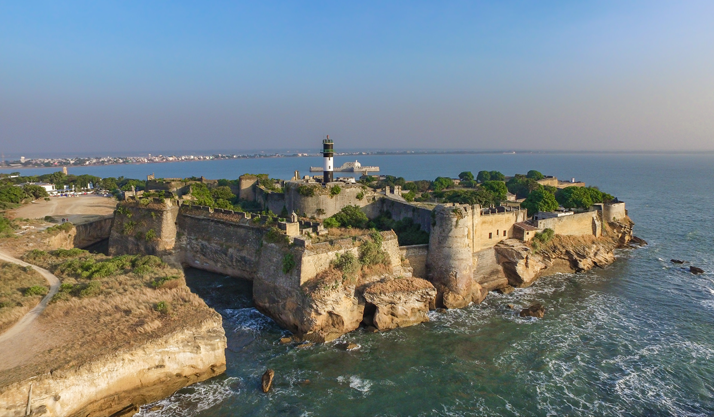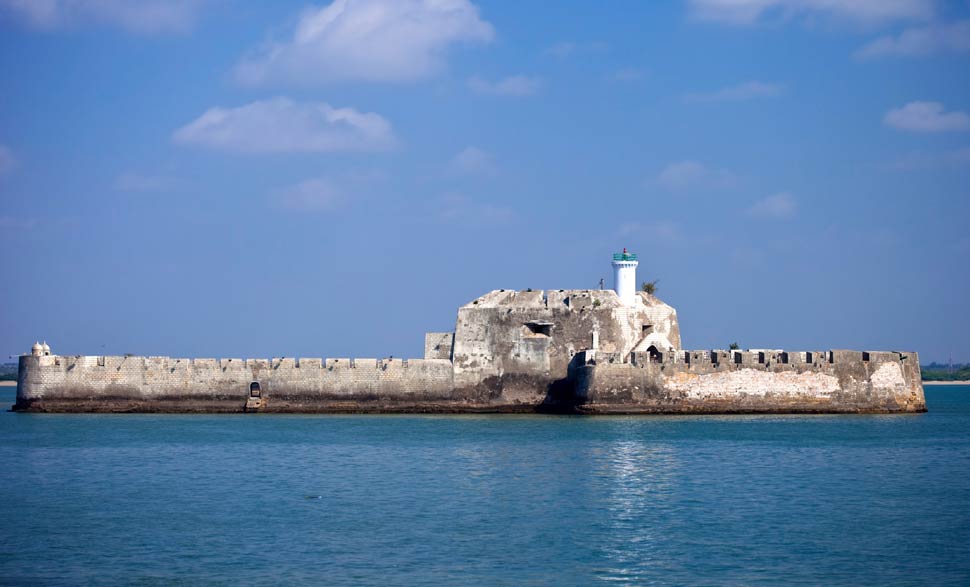The Diu Fort, is located on the west coast of India in Diu, a Union Territory, administered by the Government of India. The fort was built by the Portuguese during their colonial rule of the Diu island. The Diu town is located to the west of the fort. The fort was built in 1535 subsequent to a defense alliance forged by Bahadur Shah, the Sultan of Gujarat and the Portuguese when Humayun, the Mughal Emperor waged war to annex this territory. The fort was strengthened over the years, till 1546. Portuguese ruled over this territory from 1537 (from the year they took control of the fort and also the Diu town fully) till 1961 (for 424 years, the longest period by any colonial rule in the world) they were forced to quit only in December 1961 (even though India became an independent country in 1947) during a military action called the “Operation Vijay” launched by the Government of India, whereafter Diu was merged with India and became a centrally administered Union Territory (UT). The importance of the Diu Fort was highlighted by an opinion poll conducted (through the Internet and telephone when 239,418 people participated in Portugal) by the Portuguese (Portuguese government’s initiative) to list out the New Seven Wonders of Portugal built during their colonial rule. The Diu fort and the Basilica of Bom Jesus in Old Goa were chosen as the two wonders from India, among the seven from across the world, out of a list of 27 monuments built in 16 countries during the Portuguese rule. This list of new monuments was declared on June 10, 2009 on the occasion of the Portuguese National Day held in Portugal. The district administrator of Diu encouraged by this announcement said: A major tourism attraction in India, the listing has put Diu and the fort on the world tourist map. This will certainly give a big boost to the local tourism industry. Before the Portuguese built the fort at Diu in 1535, the ancient history of the place was linked to several Kings and Dynasties; the earliest quoted is of the Puranic period, followed by the Mauryans, the Kshatrapas from the 1st century to 415, Guptas from 415 to 467, by the Maitrakas from 470 to 788, by Chavda dynasty of Gujarat and Saurashtra from 789 to 941, by the Chalukyas (under the Chalukya as local Chieftains) and the last was that of the Portuguese colonial rule till Diu was taken, along with Goa and Daman, by the Government of India on 19 December 1961. Sultan Shah Bahadur of Gujarat had occupied the Diu island in 1330 AD. Some defense fortifications were built during his rule and of earlier Muslims rulers but the same were demolished (some remnants still exist at the eastern end of the island) by the Portuguese when they built the new fort. But the Sultan had to seek help of the Portuguese when Mughal Emperor Humayun was getting ready to attack Gujarat and annex Sultan’s territory. The Portuguese thus got the right opportunity, which they were seeking for long, to get a foothold on the Diu island to build a fort for protection of their trade. In the past, in 1501, 1521 and 1531 they had, made attempts to seize the island by force but had failed. In 1531, Nuno da Cunha (1487 – March 5, 1539) who was the governor of Portuguese possessions in India from 1528 to 1538, was under orders from the King of Portugal to build a fort at Diu to strengthen its flourishing spice trade. He launched a strong military attack to annex Diu from the Sultan, with 100 vessels and 8000 men, including 3000 Portuguese. But this campaign could only achieve bombing of Diu without getting any foothold on the island. Portuguese forces could at best torment the nearby coast. They attacked again in 1532 and 1533 but without success. But an opportunity finally knocked on their door in 1535, when the Sultan sought their help to defend against Humayun’s forces. Taking full advantage of this situation, the Portuguese diplomatically signed a defense treaty (Treaty of Bassein (1534)) with the Sultan in 1535 under which they got permission to build a fort and also to position a garrison in the fort. in addition it formalized full control of the Bassein island (the island which they had already bought from the Sultan during an earlier skirmish in 1533 and built a fort there). The Portuguese not only built a large fort at Diu by demolishing old fortifications that were existing on the island but continued to make it a formidable fortress by constantly strengthening it during the period from 1535 till 1546. After the Portuguese ambition to build a fort at Diu was met, there was total mistrust between the Sultan and the Portuguese on several issues. In 1537, in Diu harbor, the Sultan was killed in a fracas with the Portuguese. This resulted in a fight for the throne of the Sultanate of Gujarat by two claimants, but Governor Cunha’s candidate lost. This put the Portuguese in a spot vis-a-vis the throne and they quickly repaired the damage by entering into a truce with the new Sultan, which was only a temporary reprieve. In 1538, the Turks, who were ill disposed towards the Sultan of Gujarat and the Portuguese, mobilized a strong naval force comprising sixty six ships and 20,000 soldiers. Starting from Egypt in 1538 they laid siege to the fort, repeatedly assaulted and intensely bombarding it. When the fort’s forces were about to collapse, the Turks, for unknown reasons, lifted the siege and turned back to the Red Sea. Only 40 out of 400 men in the fort’s Portuguese garrison had survived. This ended Turkish attacks on Portuguese India. In June 1538, the Sultan also attacked Diu, since during the previous year the Portuguese had occupied the fort as well as the city. The rulers of Gujarat (Mahmud III, nephew of Bahadur Shah) also tried to take control of the fort in 1545 and 1546 . However, they were repeatedly thwarted by the Portuguese under the military leadership of Dom João Mascarenhas and Dom João de Castro. After this, the Portuguese enjoyed uninterrupted control over the fort and Diu island, along with Daman and Goa. In 1670 an armed group of bandits from Muscat pillaged the fort and the town. In 1960, there were only 350 Portuguese soldiers garrisoned in the fort. “Operation Vijay” was launched by India on December 19, 1961 to end Portuguese colonial rule in Goa, Daman and Diu. After Diu had fallen, the Martyrs Memorial was erected close to the Collectorate office in Diu to commemorate the Indian soldiers who were killed in the capture of Diu. The fort is easily accessible from the mainland from the village of Ghoghla in the east. or from Veraval or Somnath in the west. It is well connected by roads with rest of the country. There are no railway lines within Diu but the nearest railway station is on the metre gauge line at Delvada 8 kilometres (5.0 mi) from the fort. Diu Airport provides regular air link to Mumbai. It is located 812 kilometres (505 mi) north west of Mumbai by road. Diu is approachable from Una, which is 10 kilometres (6.2 mi) from the Gujarat border. The road distances to other places in Gujarat are: 150 kilometres (93 mi) to Sasangir and 220 kilometres (140 mi) to Bhavnagar. By Air daily flight available between Diu and Mumbai.
Gallery



